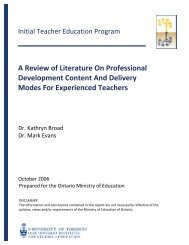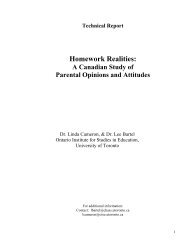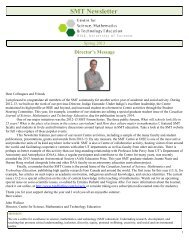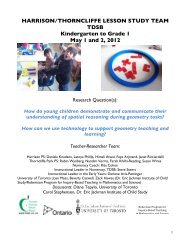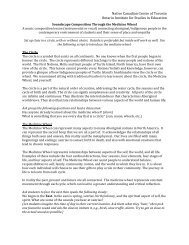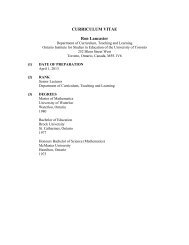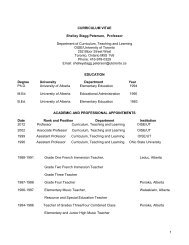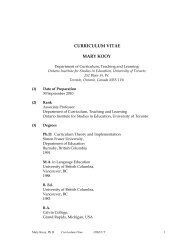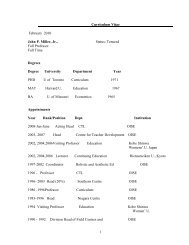The Ontario Curriculum, Grades 9-12 - Ministère de l'éducation ...
The Ontario Curriculum, Grades 9-12 - Ministère de l'éducation ...
The Ontario Curriculum, Grades 9-12 - Ministère de l'éducation ...
You also want an ePaper? Increase the reach of your titles
YUMPU automatically turns print PDFs into web optimized ePapers that Google loves.
amount of carbon dioxi<strong>de</strong> in the atmosphere; planting more trees <strong>de</strong>creases the amount of<br />
carbon dioxi<strong>de</strong> in the atmosphere)<br />
B3.3 <strong>de</strong>scribe the limiting factors of ecosystems (e.g., nutrients, space, water, energy, predators),<br />
and explain how these factors affect the carrying capacity of an ecosystem (e.g., the effect<br />
of an increase in the moose population on the wolf population in the same ecosystem)<br />
B3.4 i<strong>de</strong>ntify the earth’s four spheres (biosphere, hydrosphere, lithosphere, atmosphere), and<br />
<strong>de</strong>scribe the relationship that must exist between these spheres if diversity and<br />
sustainability are to be maintained<br />
B3.5 i<strong>de</strong>ntify various factors related to human activity that have an impact on ecosystems (e.g.,<br />
the introduction of invasive species; shoreline <strong>de</strong>velopment; industrial emissions that<br />
result in acid rain), and explain how these factors affect the equilibrium and survival of<br />
ecosystems (e.g., invasive species push out native species and upset the equilibrium in an<br />
ecosystem; shoreline <strong>de</strong>velopment affects the types of terrestrial and aquatic life that can<br />
live near lake shores or river banks; acid rain changes the pH of water, which affects the<br />
type of aquatic life that can survive in a lake)<br />
C. Chemistry: Atoms, Elements, and Compounds<br />
C1. Relating Science to Technology, Society, and the Environment<br />
C1. assess social, environmental, and economic impacts of the use of common elements and<br />
compounds, with reference to their physical and chemical properties<br />
C1.1 assess the usefulness of and/or the hazards associated with common elements or<br />
compounds in terms of their physical and chemical properties [AI, C]<br />
Sample issue: Polyethylene is a versatile, flexible, and durable compound that is used in<br />
a range of products, including toys, plastic bottles, bulletproof vests, and plastic bags.<br />
However, its durability poses problems for the environment because products ma<strong>de</strong> from<br />
polyethylene are not bio<strong>de</strong>gradable.<br />
Sample questions: … What property of DDT allows it to continue to accumulate in the<br />
fatty tissue of mammals <strong>de</strong>spite its ban by the Canadian government in the 1980s? How<br />
do the chemical properties of peroxi<strong>de</strong> make it suitable for use in hair dye? What are the<br />
hazards associated with this use?<br />
C1.2 assess social, environmental, and economic impacts of the use of common elements or<br />
compounds [AI, C]<br />
Sample issue: By reducing the accumulation of ice on roads, road salt makes winter<br />
driving safer, <strong>de</strong>creasing medical and insurance costs associated with motor vehicle<br />
acci<strong>de</strong>nts. But the compounds in road salt damage roads and vehicles, pollute water<br />
systems, and harm animals and vegetation.<br />
Sample questions: How has the presence of mercury in water bodies in Northern <strong>Ontario</strong><br />
affected the environment and the lives of Aboriginal people? How does the wi<strong>de</strong>spread<br />
use of agricultural chemicals in Canada or elsewhere affect the economy, society, and the<br />
environment? What are the economic benefits and environmental costs of diamond<br />
mining for Northern Canadian communities?<br />
Science 99



